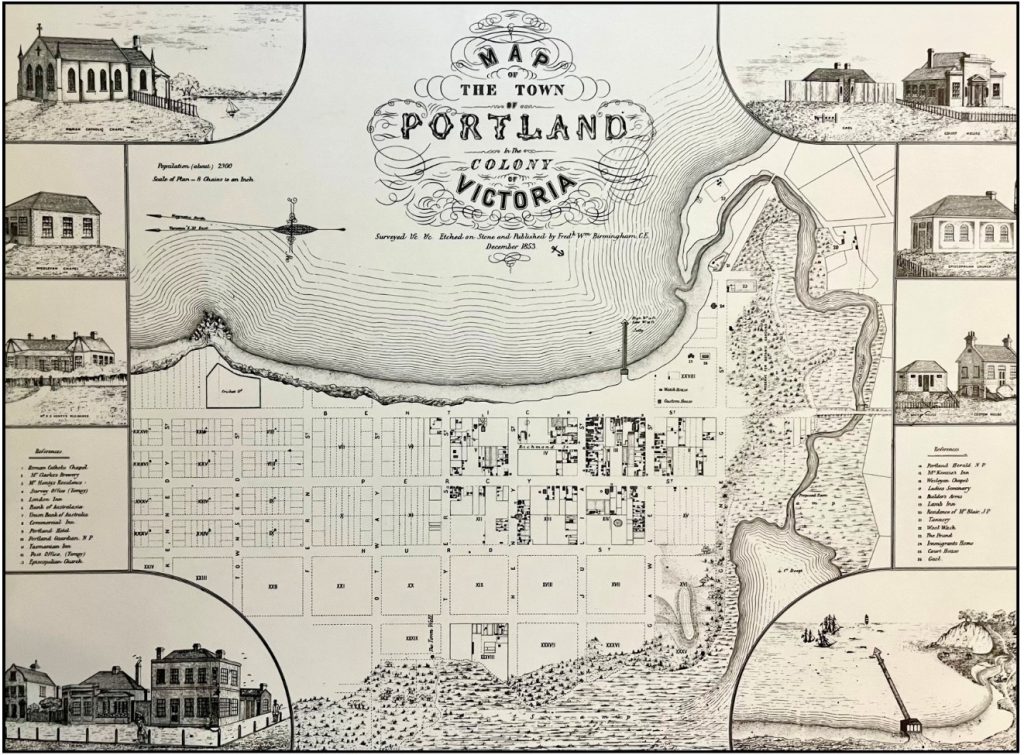MARY’S PORTLAND
‘Virtue is perfected in adversity’ – Mary MacKillop, 1864
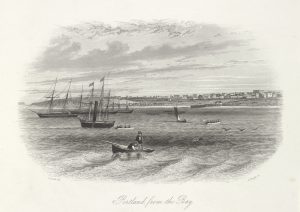
The city of Portland, located on the southwest coast of Victoria in Gunditjmara Country, was a significant location in the early life of Saint Mary MacKillop. First established in 1834, Portland remains Victoria’s oldest permanent European settlement. Mary was a resident during the 1860’s when Portland’s population sat at approximately 3,000 people. This high population number was a result of a strong economy based upon the deep-water seaport, the only one located between Melbourne and Adelaide, through which 12,000 immigrants had passed over the previous decade. The port facilitated the export and distribution of wool and other materials by sea and land. The economy was further supported by the Victorian gold rushes. Travellers from Melbourne and Adelaide would arrive via ship, coastal steamers, horse and coach, and the journey only undertaken as a necessity. The Portland Guardian paper as well as the telegraph were the main means of communication. Today, the rich history of Portland can still be observed with the preservation of around 200 historical buildings, many of which continue to recognise the early life of the Portland settlement and Mary MacKillop’s contribution to its community.
In June 1862, at the age of 20, Mary arrived by Cobb & Co. Coach in Portland to work as governess to her distant relations, Mrs Eliza Lee Cameron and her daughters Sarah, Till and Bella. Mary was an experienced governess, only recently returning from her two-year appointment in Penola with another Cameron family, and prior to this working with the L’Estrange family in Melbourne. During the almost four-year period that she would spend in Portland, Mary would face ill-health and financial debt, gender inequality and damaging public opinions, as well as the weight of familial responsibility.
‘The thought of God’s immense love and mercy come before me with a force I cannot describe’ – Mary MacKillop, 1869
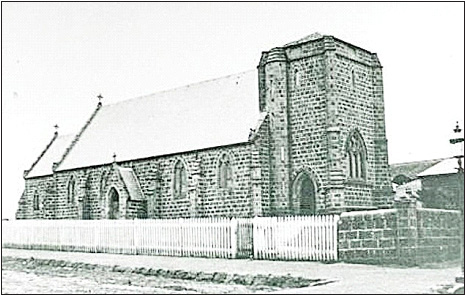
Mary’s desire to observe a religious life is apparent during her time in Portland, a settlement that had already established centres for the major religions of the day. The Church of England was the dominant group, although other communities had established their own churches paid for by prescription. The Catholic All Saints Church had been constructed between 1857 – 1862 and completed only months prior to Mary’s arrival to the settlement. Stained glass windows were added in 1995 – 1996 to commemorate Mary’s beatification and her deep involvement with Portland’s Catholic community.
Mary acted as Sacristan at All Saints. She wrote in October 1864, ‘one great happiness I enjoy, is, I have charge of the Altar and Lamp, and being able to go into the chapel at any time, where the Blessed Sacrament always is, is a precious favour indeed’. In Mary’s letter to Father Julian Tenison Woods, whom she had met during her stay in Penola, she made him aware of her desire to follow her religious calling. However, at this time Mary continued to prioritise her familial obligations as provider; her father Alexander held no employment and she was the eldest of eight siblings.
For the MacKillops, Portland presented a unique opportunity to bring the whole family together in one location. Mary received income through two separate educational-based opportunities; bringing the family together was now financially viable. Mary’s younger sister Maggie wrote in 1864; ‘I do not remember ever being so happy… I would not ask for more happiness in this world than to see Papa, Ma and all my dear brothers and sisters happy and comfortable...’ The inclusion of Mary’s father Alexander did raise the concern of Father Tenison Woods, due to his history of flawed financial dealings. This was highlighted in Portland when money promised by Mary’s Grandfather to buy a piano was used by Alexander instead for the purchase of other material goods. Portland would be the last time the MacKillop family lived all together.
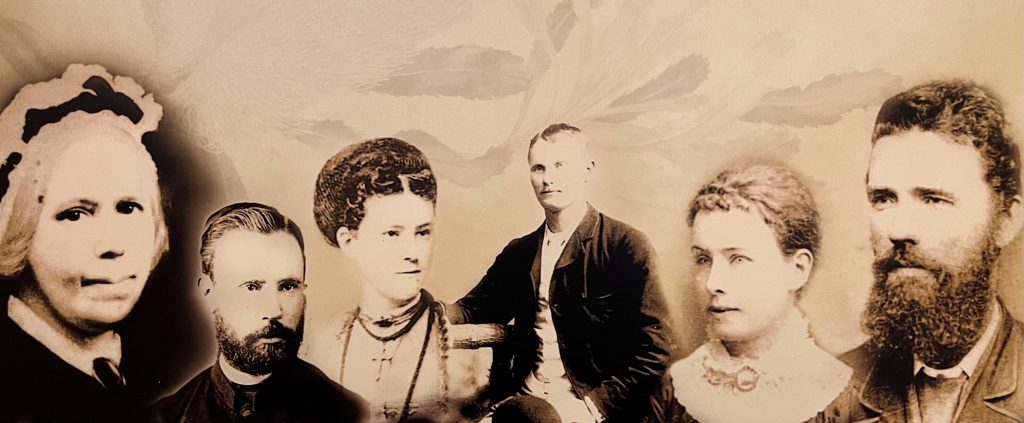
‘We must teach more by example than by word’ – Mary MacKillop, 1867
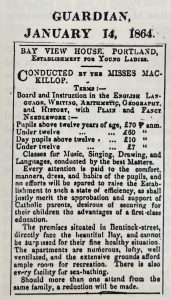
By mid-1863, the Cameron family for whom Mary was a governess left for Sydney, and a teaching opportunity arose at the Catholic denominational Common School 510. Funded by the colonial government, the school was overseen by a committee which included the parish priest and was run by a Head Teacher supported by assistant and student teachers. Assistant teacher Mrs Devitt was leaving, providing an opening for Mary. She received a conditional offer of appointment in the September, which took effect on the 1st of October. Although Mary lacked formal training, she sat an examination that same month for her teaching certificate and was supported by Reverend P.A. Courtney. This would be Mary’s first experience with formal teaching. Her sister Annie would join her as staff the following year. Mary would remain with Common School 510 until her resignation on the 23rd of September 1865 following the events of the Cusack Affair.
Bay View House Seminary for Young Women was a business venture Mary established from 1864 while maintaining her teaching position at Common School 510. Mary rented the Bay View House property from the Henty brothers, with Alastair Cameron of Penola taking responsibility for the lease. The original building, located on Bentick Street overlooking Portland Bay, was constructed in the 1850s for educator John Browning. It is currently the site of Bayview College, with the original building incorporated into the architectural elements of a new school structure, and the stables remaining largely in their original state. Bay View House Seminary for Young Women was the first school established by Mary MacKillop. The school was overseen by Mary, her sisters Maggie and Lexie ran classes, and Flora maintained the property. The school was attended by both day students and boarders, with offerings in music, drawing, languages, history, writing, arithmetic, geography, as well as plain and fancy needlework. The income generated would maintain both the school and Fitzroy Cottage. Fully operational by the end of 1863, by the middle of the following year, MacKillop family members suffered with ill-health, and Mary was in a dispute over her pay at Common School 510. By 1865, maintaining two properties became unmanageable. At the end of the year, the school closed; male boarders were taken in and female students transferred to Fitzroy Cottage.
‘Make allowances for those who do not see as you do’ – Mary MacKillop, 1867

An adjustment to the pay system of teachers within the state of Victoria’s education system changed the course of Mary’s life in Portland. In April 1863, teachers were to be paid by result, meaning the quality of education they provided for their students could increase or decrease their wages. Inspector Venebles arrived in Portland in 1865 to examine the settlement’s three Common Schools. Young Mary had prepared her class well; however, Head Teacher John Cusack transferred her best students into his own class, and less gifted into Mary’s. While Inspector Venebles was conducting his examination, Cusack held up a blackboard with answers behind his back. Mary told Father Riordan, who chose to take no action against the Head Teacher. Mary’s 12-year-old brother Donald was in Cusack’s class and informed their father Alexander of Cusack’s actions. Alexander then informed the pastor, which ultimately resulted in Cusack being accused of falsification of rolls and assisting the students. He was dismissed, despite receiving the support of Father Riordan. Alexander also refused to allow Annie to continue teaching at the school, thus diminishing the family’s finances. The community was divided; Mary reflected on this event, ‘for four months this storm raged – and I stood alone’ (1873).
Mary resigned from Common School 510 on the 23rd of September, 1865. The fallout from this event continued; on the 9th of November the Portland Guardian reported on an incident involving Mary’s father Alexander. Following insults and taunts from a group of youths, Alexander took the matter to the Portland Magistrates Court. He wanted an opinion as to the character of the insults, not an actual punishment, to which the case was dismissed. Despite the consequences of the Cusack Affair, Sister M. Rosalie (b.1883 – d.1972), of the Sisters of Saint Joseph of the Sacred Heart wrote, ‘years after, Mother [Mary] was in Sydney and whilst waiting for a boat in Circular Quay, saw the schoolmaster. He was old, crippled and in rags; at once Mother recognised him and offered help.’
‘Remember we are but travellers here’ – Mary MacKillop, 1867
By the end of 1865, Portland no longer provided opportunities for Mary. The Cusack Affair had divided the community and disgraced the family’s reputation, many suffered from ill health, and they were in severe financial debt. Providentially, a teaching position opened in Penola. By the January of 1866, Mary left with her sister Lexie to join Annie in Penola. Alexander’s brother, Peter Mackillop, took him in at his property at Dunkeld and sister Maggie to another property in Duck Ponds. Brother John sought work in South Australia, while mother Flora and two brothers Donald and Peter remained in the settlement.
In this period directly after leaving Portland, Mary would establish the Stable School in Penola and the Sisters of Saint Joseph of the Sacred Heart with Father Julian Tenison Woods. Portland prepared Mary for her future; forty years after her time in Portland, Mary herself wrote: ‘Miss M – was acquiring in the Portland school the experience and practical knowledge which fitted her for the work she was designed for…’







